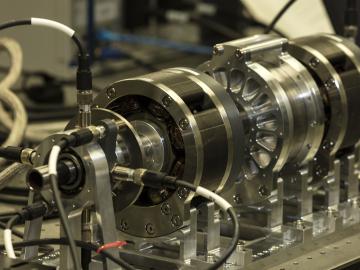Filter News
Area of Research
- (-) Materials for Computing (6)
- (-) Nuclear Science and Technology (7)
- Advanced Manufacturing (3)
- Biological Systems (1)
- Biology and Environment (52)
- Biology and Soft Matter (1)
- Building Technologies (2)
- Clean Energy (98)
- Climate and Environmental Systems (2)
- Computational Biology (1)
- Computer Science (1)
- Electricity and Smart Grid (1)
- Fossil Energy (1)
- Functional Materials for Energy (2)
- Fusion and Fission (15)
- Isotopes (3)
- Materials (85)
- National Security (25)
- Neutron Science (29)
- Renewable Energy (3)
- Supercomputing (61)
- Transportation Systems (1)
Media Contacts

Tackling the climate crisis and achieving an equitable clean energy future are among the biggest challenges of our time.

Oak Ridge National Laboratory researchers collaborated with Iowa State University and RJ Lee Group to demonstrate a safe and effective antiviral coating for N95 masks. The coating destroys the COVID-19-causing coronavirus and could enable reuse of masks made from various fabrics.

A study by researchers at the ORNL takes a fresh look at what could become the first step toward a new generation of solar batteries.

Drilling with the beam of an electron microscope, scientists at ORNL precisely machined tiny electrically conductive cubes that can interact with light and organized them in patterned structures that confine and relay light’s electromagnetic signal.

More than 50 current employees and recent retirees from ORNL received Department of Energy Secretary’s Honor Awards from Secretary Jennifer Granholm in January as part of project teams spanning the national laboratory system. The annual awards recognized 21 teams and three individuals for service and contributions to DOE’s mission and to the benefit of the nation.

Researchers at ORNL used polymer chemistry to transform a common household plastic into a reusable adhesive with a rare combination of strength and ductility, making it one of the toughest materials ever reported.


When it comes to a challenging application for embedded instrumentation and control, none quite beats an environment of molten salt at 700 degrees Celsius. But that is just the application chosen by scientists at the US Department of Energy’s Oak Ridge National Laboratory...


Renewed interest in molten salt technology was evident at a recent gathering of advanced nuclear reactor experts at the US Department of Energy’s (DOE’s) Oak Ridge National Laboratory (ORNL). Nearly 200 attendees from national labs, industry, utilities, reactor design firms,...




